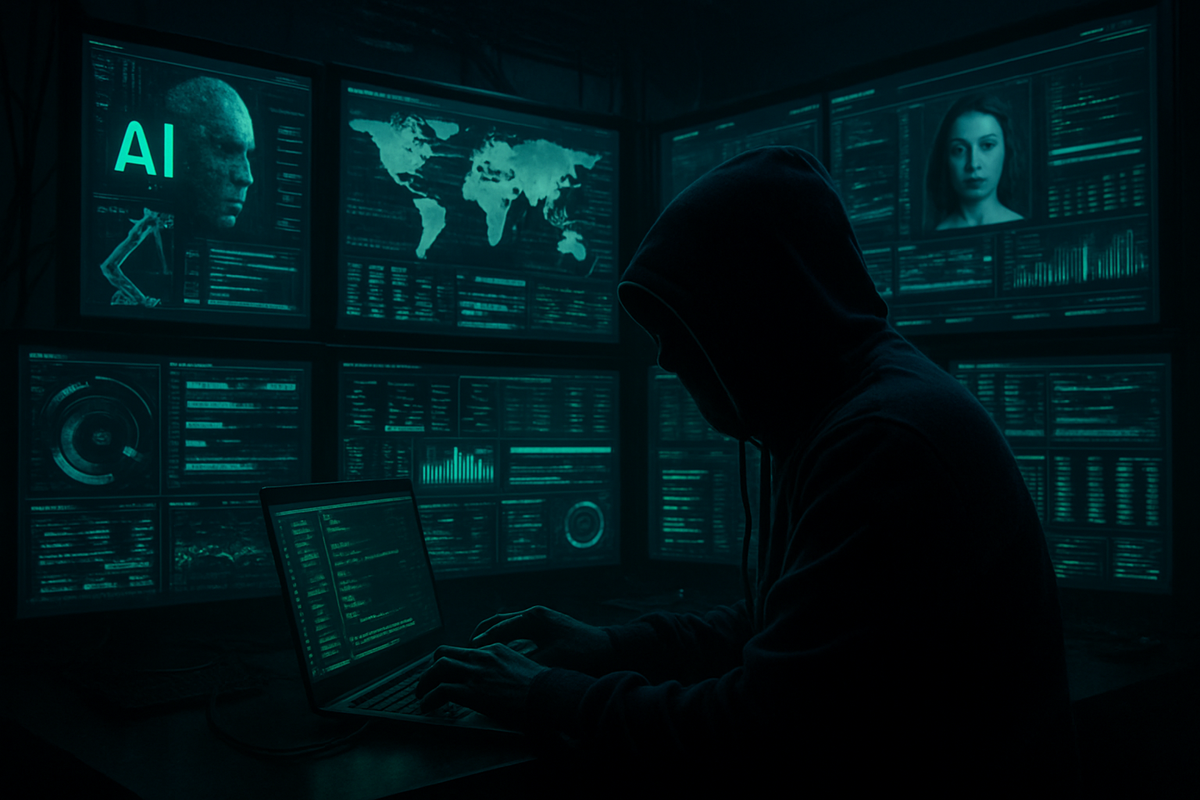AI Hackers: Inside the New Era of Automated Cybercrime (And How to Defend Against It)
AI hackers aren't fiction; they're real, deploying bots to carry out cyberattacks at lightning speed. Learn how the cybersecurity industry fights back and how you can protect your business from this new era of automated cybercrime.

AI Hackers: Inside the New Era of Automated Cybercrime (And How to Defend Against It)Published: August 4, 2025 | By Funaix Editorial Team
Welcome to the Wild West of Cybercrime—Now With AI Cowboys
Picture this: Hackers no longer hunched over glowing screens, furiously coding in dark basements. Instead, they whisper, "Hey AI, take down my competitor’s website," and watch as their digital minions get to work. Sound dramatic? It’s not science fiction—it’s your inbox, your business, and your bank account at stake, right now.
"AI is democratizing cybercrime. The technical barriers are falling—fast."
— Richard Hummel, Threat Intelligence Director, Netscout
Let’s break down the real threats, real cases, and real solutions for surviving (and thriving) in the age of AI-powered cyberattacks. Grab a coffee—this is the cyber-thriller you need to read before your next password reset.
The Rise of AI-Driven Attacks: What’s New, What’s Terrifying
DDoS-for-Hire Goes Full Robot: Attacks at Machine Speed
Distributed Denial of Service (DDoS) attacks once required technical skill, time, and patience. Today, AI chatbots like GhostGPT and WormGPT let even beginners launch multi-vector attacks with a simple prompt. These bots can:
- Automate reconnaissance and target selection
- Adjust attack parameters in real time
- Evade classic defenses by mimicking legitimate traffic
- Orchestrate attacks across entire networks, not just single sites
Case in point: In 2025, major US agencies and businesses saw over 400 SharePoint servers compromised, with attackers using AI to stay ahead of every patch and countermeasure (Axios, July 2025).
Deepfakes: The Art of Deception, Now at Scale
AI-generated audio and video forgeries aren’t just for political drama. Scammers use deepfakes to impersonate CEOs, trick employees into transferring funds, or even apply for jobs with fake credentials. In a world where you can’t believe your eyes—or ears—trust becomes the new currency.
"It’s no longer about hacking systems—it’s about hacking trust."
— Brian Long, CEO, Adaptive Security
AI as a Data Sprawl Supercharger
AI doesn’t just use your data—it creates more of it. Reports, logs, models, and metadata pile up, overwhelming even the best IT teams. Unmanaged data is a goldmine for attackers, especially when legacy backups or forgotten files contain sensitive info. In 2025, 74% of surveyed security leaders reported attackers successfully accessed and harmed their data, with 86% paying ransoms (TechRadar, July 2025).
The Cybersecurity Industry Strikes Back: New Tools, New Tactics
AI vs. AI: Let the Bots Battle
The only thing faster than an AI hacker? An AI defender. Security teams are deploying:
- Machine learning-based detection to spot attacks in real time
- Autonomous incident response—playbooks that adapt at machine speed
- AI-powered threat intelligence sharing to keep the community ahead of the next big exploit
Leading security firms and startups are integrating AI into everything from network monitoring to phishing detection, making cyber defense smarter, faster, and (dare we say) a bit more fun for the good guys.
Identity Is the New Perimeter
Forget firewalls—identity is the new battleground. Major acquisitions (Palo Alto Networks buying CyberArk for $25B) signal a shift: protecting who is accessing what is now priority #1.
- Privileged access management: Limit admin rights, monitor sensitive actions
- Zero trust frameworks: "Never trust, always verify"—especially for AI agents and bots
- Machine identity protection: Secure not just humans, but the bots and scripts running your business
Your Action Plan: How to Defend Against AI-Powered Cybercrime
Ready for a checklist that actually works? Here’s your game plan for 2025 and beyond:
- Upgrade Your Defenses: Use AI-enhanced security tools. If your antivirus is still asking for floppy disks, it’s time to move on.
- Lock Down Identities: Enable multi-factor authentication (MFA) everywhere. Yes, even on your smart fridge.
- Patch Like a Pro: Update software promptly, especially cloud apps and collaboration tools (looking at you, SharePoint!).
- Educate Your Humans: Train staff to spot phishing, deepfakes, and suspicious requests. Make "trust but verify" your office mantra.
- Automate Data Hygiene: Use automated tools to discover, classify, and clean up old data—before an attacker does it for you.
- Have a Plan (and Test It!): Incident response is not a "set it and forget it" deal. Run drills. Reward the best disaster recovery story with coffee (or therapy).
Pro tip: For individuals, use password managers, enable privacy settings, and be skeptical of any "urgent" video call from your CEO—especially if their mouth doesn’t quite match their words.
The Future: Stay Alert, Stay Informed, Stay Human
AI-powered cybercrime isn’t going away. But neither is the human ingenuity that keeps us one step ahead. The best defense? Community—sharing threat intel, digital literacy, and a healthy dose of skepticism.
"The era of ignoring data sprawl is over. Treat data as both a strategic asset and a security liability."
— Michael Mestrovich, CISO, Rubrik
If you’ve made it this far, you’re already ahead of the curve. Want more smart news, practical tips, and the occasional cyber-saga? Subscribe to Funaix for free—and join a community where only subscribers get to read and write blog comments. (For now, your subscription is free. Your data? Priceless.)
Enjoyed this article? Subscribe to Funaix for exclusive insights, smart news, and the chance to join the conversation in our lively comment sections. Stay savvy, stay secure!




